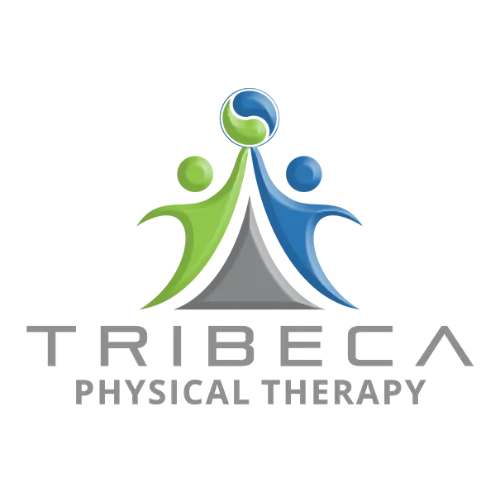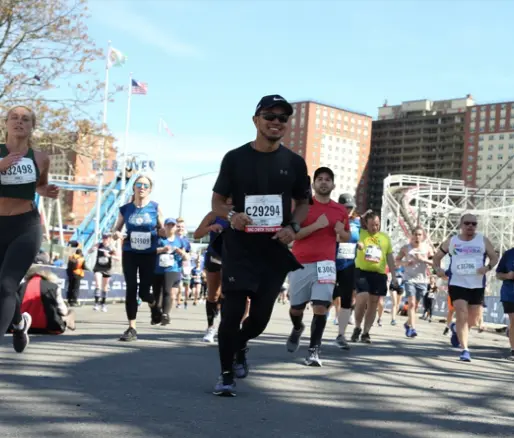Running injuries are inevitable. Running is considered the simplest or most convenient fitness activity and many experts believed that people are built to run. In fact, there is scientific evidence that supports the notion that humans evolved to be runners. Experts think that the shapes of our hips and feet, the length of our legs, our shock-absorbing spinal discs, and our ability to sweat rather than panting make it possible for us to run mile after mile. So, it’s perhaps no surprise that running is strongly associated with several benefits for our bodies and brains. It can significantly improve physical and mental health. It can reduce stress, improve cardiovascular health, and even help alleviate symptoms of depression. Some researchers think running may be so good for us because it’s something we evolved to do. Most mammals can sprint faster than humans – having four legs gives them the advantage. But when it comes to long distances, humans can outrun almost any animal.
Photo from Popular Brooklyn Half marathon 2019
Although it is considered the simplest form of exercise, it is estimated that 82% of all runners suffer injuries during their running careers. This is probably because the repeated movements involved can be hard on the body. Whether you’re running for pleasure or training for a race, you’re bound to have aches and twinges along the way. So, what are the common running injuries and how can you prevent and recover from them? There are two types of running injury, it can be acute or chronic. Acute injuries are sudden, sometimes violent injuries. These include broken bones, sprains, and lacerations. While Chronic (or overuse) injuries are due to a low-grade, abnormal force being applied repeatedly over a prolonged period. We’ve also cited few specific types of running injuries and their treatments, see below:
Plantar fasciitis. This injury involves small tears and inflammation of the tendons and ligaments of the foot, resulting in pain that might feel like a dull ache or bruise along your arch or heel. The primary symptom of plantar fasciitis is pain in the bottom of the foot, from the heel into the arch. The discomfort may be present at the start of a run, subside during the run, and then recur later. Feet with a high arch (supinator, or a person who rolls his or her feet too far outward while running). The best method for preventing plantar fasciitis intrinsic foot activation, arch stabilization, and stretching. There are 10 intrinsic muscles located in the sole of the foot. They act collectively to stabilize the arches of the foot, and individually to control the movement of the digits. Imagine creating a dome on the arch of the foot pulling the sole to the heel while standing and holding it for a few seconds. The plantar fascia can be stretched by grabbing the toes, pulling the foot upward, and holding for a few seconds. To stretch the calf muscles, place hands on a wall and drop the affected leg back into a lunge step while keeping the heel of the back leg down. Keep the back knee straight for one stretch and then bend the knee slightly to stretch a deeper muscle in the calf.
Achilles tendonitis – The tendon tightens and gets irritated, leading to the pain in the back of the foot. Achilles tendonitis is characterized by pain with heel strike, pain when the foot lands on a curb, when running up the stairs, or with a sudden change of direction. Pain may be more prominent in the morning with the first few steps out of bed. This is because the calf muscle in shortened in sleeping positions. To help prevent Achilles tendonitis from occurring, proper stretching and postural awareness such as leaning facing the wall with your back leg straight for the gastrocnemius muscles or knee slightly bent for stretching the soleus muscles. It would also be beneficial to consider proper shoe maintenance.
Runners’ knee – When a person has a runners’ knee, the pain builds up gradually and is usually located beneath or around the kneecap. The pain is aggravated by squatting and going up and downstairs. Going down the stairs on the stabilizing is a very common symptom production since the quads eccentrically support the forward descent of the whole body. Stiffness in the knee after prolonged sitting is also a symptom of this injury. Causes may include: Efforts to prevent runners’ knee from happening to begin with strengthening. Hip strengthening is very important for runners in avoiding injury. To strengthen the hip abductors, lie on your side, keep your hip and knee in a straight line and kick your leg up towards the ceiling keeping your leg in line with the body. To strengthen the hip extensors, lie on your stomach, squeeze your buttock muscles, and lift your leg off the ground. A runner should perform strengthening slowly and with good control. Make sure there is no compression pain on the lower back.
Iliotibial band (ITB) syndrome – This type of injury is characterized by pain on the outside of the knee while running. A runner may also experience pain on the outside of the hip. With this injury, a runner may notice the pain more on slower runs than fast runs, running hills, or going up or downstairs. Stretching of the IT band can help prevent running injuries. To stretch this soft tissue, stand with the affected leg towards a wall, cross the unaffected leg in front of the affected leg, place arm on the wall and drop hips towards the wall. You should feel the stretch on the side of the hips or side of the knee.
Shin splints – It may seem small, but these are tears happening around your shinbone and can develop into something more serious. As the name suggests, a shin splint injury is a pain in the shin while running. The pain first starts after running but then progresses to persistent pain. If you continue to have pain, you should visit your doctor. The best way to help prevent shin splints is to practice good shoe maintenance. Most importantly, a runner should wear shoes that are appropriate for his or her foot type and training intensity. You may need prescription orthotics if the foot mechanics cannot be controlled with a shoe alone (e.g., to correct for overpronation). A running shoe needs to have good shock absorption to decrease the stress on the shins. Running shoes lose 30% to 50% of their shock absorption ability after about 250 miles. Shock absorption is greatly reduced when running in wet shoes. To assure adequate shock absorption when running every day, a runner should alternate shoes. Running shoes need to be replaced every 400 to 600 miles to help prevent injuries like shin splints.
Stress fractures – Stress fracture injuries cause persistent pain, most commonly in the shin, but at times in the foot, hip, thigh or pelvis. Causes and treatments for stress fractures are similar to the ones that apply to shin splint injuries. However, stress fractures are more severe than shin splints and require serious management. Some runners may be immobilized in a walking boot or be required to use crutches to allow the stress fracture to heal. Sometimes surgery is required if the stress fracture is severe enough or is in an area of high risk. Cardiovascular training must focus on non-weight-bearing activities like swimming. The best approaches to preventing stress fractures are proper training, proper shoe maintenance, and not running on excessively hard surfaces. A physician should be consulted if you suspect you have a stress fracture during your training.
There are also some exercises that may help you to be free from running injuries. Here are some of the helpful tips physical therapists want runners to do:
Foam Roll: Calves and Quads – Foam rolling is one of the easiest ways to keep muscles free from hardening. The most important thing to remember while foam rolling is to move slowly up and down the muscle, remembering to turn the body slightly to get the outer and inner parts of the quads and calves. This simple technique is good to do pre and post-run.
Trigger Point release: TFL – If there’s a discomfort runner knows well, it’s a tight IT band. But it turns out, our IT band isn’t a muscle and really can’t get ‘tight.’ However, it does attach to a small muscle towards the front outer hip called the tensor fascia latae (TFL), which can get overworked and tight in a lot of runners causing it to pull on the IT band and create a sensation of tightness. It can be released with foam rolling to a degree but since it is a small muscle, I find that digging in with a lacrosse ball is more effective.
Hip Flexor Stretch – If you spend most of your day sitting, the hip flexor stretch is for you. The most obvious way that tight hips affect running is that runners can’t let their legs extend behind them in their stride. Normally the hip flexor would act as a rubber band, getting stretched out and then recoiling as you pick your foot up. Since most people are too tight to allow it to get properly stretched out, they then overwork the muscles when driving their foot forward.
Squats – Tight quads, weak glutes, and weak hamstrings. Sound familiar? It should because it’s the norm for most runners. This muscle strength and length imbalance is one of the biggest reasons for pathology in runners along with poor running form and mechanics. Squats are a great way to build a strong foundation for running. Varying the foot position is a good way to ensure you’re hitting all aspects of the muscles. Ask your physical therapist to teach you squatting while keeping your pelvis tilted posteriorly!
Walking Lunges – Why walking lunges? Because they mimic running and are more dynamic! Take a big step forward, try to keep the weight evenly throughout the foot but to prevent the knee from moving forward too much. Shift as much weight as possible onto the front leg (while preventing the knee from moving forward over the toes) and then reach forward and down right in front of the lunging leg’s knee. Reaching forward and down helps counterbalance your hips and makes it easier to keep the knee back. You should primarily feel this in the hamstring and glutes.
Side Lunges – Why side lunges? Because runners often lack mobility in the frontal (side to side) and transverse (rotational) planes. Side lunges get you to move into the frontal plane and open the hips, stretching the adductors slightly while also strengthening the glutes.
Rotational Lunges – For similar reasons to the side lunges, rotational lunges are great because they open the hips in ways that most exercises don’t. Most of these exercises I view as part strength and mobility, but that is particularly true for this one.
Carioca – an exercise that focuses on stretching the glutes, hips, and ankles. It is a dynamic stretching used to increase mobility and blood flow to soft tissues prior to running. Move sideways with legs crossing each other, leg in front, then leg in back. Hold arms straight from shoulders for balance and while keeping your trunk straight, twist hips as legs crossed. Stay on the balls of your feet with your hips in a low semi-squat position.
Knowledge about preventing and recovering from an injury is essential for runners. A timely response will help you avoid acute injuries that could pull you from the pavement for an indeterminate hiatus. To understand more about how physical therapy can help you please contact Tribeca Physical Therapy.



